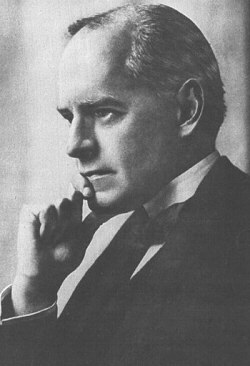









|
II English Novels from 1900s to 1950s
1. John Galsworthy (1867-1933)
Life
 John Galsworthy was born into a well-off family in Surrey in 1867. His
father was a lawyer and a director of several companies, mother a daughter
of a manufacturer. He received education at Harrow School, Middlesex from
1881-1886, then in New College, Oxford, where he graduated with honors in
law. Then he was admitted to the bar in 1890. He traveled widely and met
Joseph Conrad in 1892 who became his life-long friend. He started his
writing career from 1895, at first for his amusement, when he found writing
was the most enjoyable in life. He married Ada Person Cooper in 1905, a
woman who became the inspiration of many his novels. During the First World
War he worked for the
Red Cross, and helped refugees in Belgium. He got the
order of Merit in 1929 and was awarded the
Nobel Prize for literature in
1932. John Galsworthy died on January 31, 1933.
John Galsworthy was born into a well-off family in Surrey in 1867. His
father was a lawyer and a director of several companies, mother a daughter
of a manufacturer. He received education at Harrow School, Middlesex from
1881-1886, then in New College, Oxford, where he graduated with honors in
law. Then he was admitted to the bar in 1890. He traveled widely and met
Joseph Conrad in 1892 who became his life-long friend. He started his
writing career from 1895, at first for his amusement, when he found writing
was the most enjoyable in life. He married Ada Person Cooper in 1905, a
woman who became the inspiration of many his novels. During the First World
War he worked for the
Red Cross, and helped refugees in Belgium. He got the
order of Merit in 1929 and was awarded the
Nobel Prize for literature in
1932. John Galsworthy died on January 31, 1933.
Galsworthy was English novelist and playwright of
international fame. In his lifetime Galsworthy wrote 17 novels, 26 plays and
12 collections of short stories, essays and poems etc. His early novels
written under the pen name John Sinjohn were From the Four Winds
(1897), Jocelyn(1898), Villa Rubein (1900), and A Man of
Devon (1901). His first novel under his real name was Pharisees
(1904). Galsworthy’s novels dealt with the life of the upper class and their
decline. His reputation of novels mainly rested on his trilogies, in which
The Forsyte Saga was the first. It included Man of Property
(1906), In Chancery (1920), and To Let (1921). The three
novels appeared with two “interludes”. The two interludes were Indian
Summer of a Forsyte (1918) and Awakening (1920). The first
trilogy was followed by its sequel trilogy, A Modern Comedy, which
consisted in The White Monkey (1924), The Silver Spoon (1926)
and Swan Song (1928). His Forsyte novels were adapted on television
and enjoyed popularity by many Europeans.
As a playwright of considerable technical skill, his
plays often took up specific social problems. The Silver Box (1906)
is about the double standard of justice as applied to the upper and lower
classes. Strife (1909) is dealing with the confrontation of capital
and labor. His other major plays are Justice (1910), The Mob
(1914), and The Skin Game (1920).

|
![]()
![]()